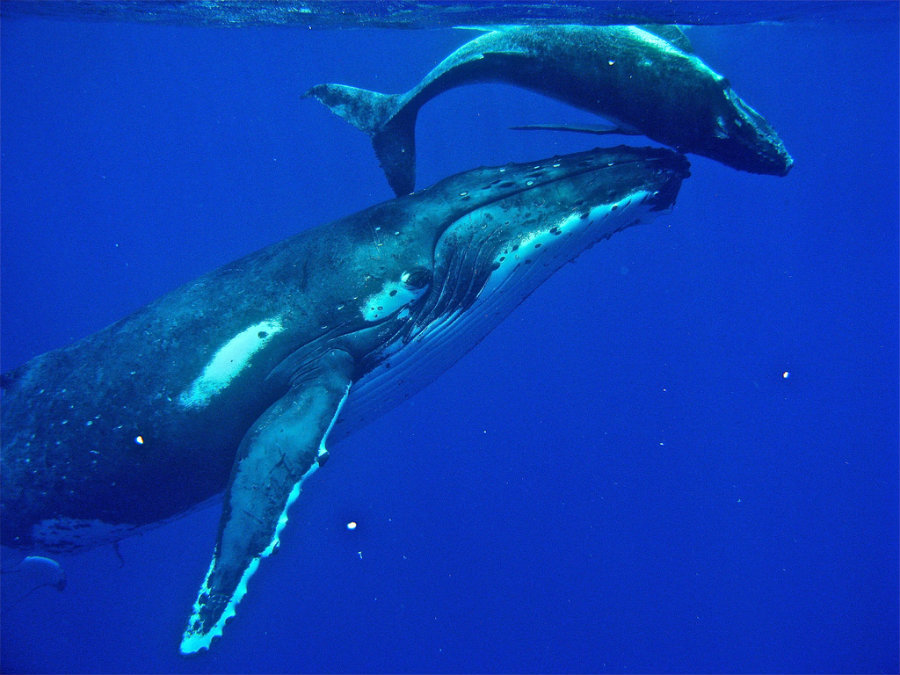Baby humpback whales seem to whisper to their mother whales to avoid predators. Scientists have recently captured the calves’ quiet grunts and squeak for the first time, but they can only be heard at close range.
Humpback whales are known scientists for their loud haunting songs. However, the sounds of baby whales are very different from those “songs” sung by adult male humpback whales. Now scientists want to know more about the life of baby whales.

“It’s like a squeaky sound, and some of them are really like grunting sounds,” Videsen says. “What’s more, the sounds are very quiet, like the baby humpback is whispering so that it won’t get overheard by something dangerous lurking nearby”.
The early stages of baby whales are elusive
According to Simone Videsen at Aarhus University in Denmark, baby whales are around 5 meters long when they are born, which means they are pretty big considering that they are babies. Baby whales travel with their mothers for thousands of miles during annual migration to the food-rich waters of the Antarctic. No one is sure about what happens during that period.
The life of baby whales is quite a mystery because they spend most of the time under water, so scientist cannot keep track on their activities. However, they know that these early stages of their lives are crucial for their development and survival.
“These early life stages of wild whales are so elusive because they’re an aquatic animal,” Videsen explains. “We can’t follow them around all the time to see what they’re doing.”
To find out more about the first months of baby whales, Videsen and his colleagues were able to attach devices on baby humpbacks. They tracked eight in total in the Exmouth Gulf off Western Australia.
The used special sound and movement recorders, which had suction cups that allow scientists to stick them on the calves’ skin. They could stay there for about a day, and then they fall off.

Killer whales attack baby whales
Scientists didn’t know what they would hear in these recordings, so when they finally played the audios, they discovered the great difference of sounds between adults and baby whales. Adults’ sounds can be heard 20 miles away, while calves’ sounds are soft, almost as a whisper to their moms. They can only be heard at short range. Scientists say that calves whisper to their mother, so their mother can prevent killer whales from attacking the calves. Most of the babies’ whispers occur when they are swimming with their mothers, rather than when they are resting.
The soft sounds help the mother to track the calves and avoid being overheard by killer whales, other predators or even male humpbacks who are searching for a mate.
“There are lots of killer whales in the area which are predating on these calves,” says Videsen, “and they can use these sounds between mother and calf as like homing cues.”
Videsen stated that they were surprised to see that even if these whales tend to sing long songs, the communication pattern between mother and calf is quite the opposite. They also heard a different noise, like a rubbing sound. According to Vidisen, it’s like two balloons being rubbed to each other. Scientists think that it means that the calf wants to tell her mother that it wants to nurse.
The research was published in the journal Functional Ecology
Whales breed in tropical waters, and then they migrate to feed
Humpback whales are slow to reproduce. Their pregnancy lasts about 11 months, and calves follow their mother at least until they are one-year-old. They have to stay close to her to feed and grow – and gain as much weight as it is possible – before they set off on their annual migration.
According to scientists, there are two significant humpback whale populations in the world: one in the northern hemisphere and the other in the south. Both of them breed in tropical waters, and they start a long journey to the Arctic or the Antarctic to feed. They must feed and save energy to cope up with 5000 miles travel across the oceans. The migration is very demanding for the baby whales.
Vidisen said that this research allows them to know more about what could disrupt this critical time in the life of a calf, and how they can target conservation efforts more effectively. They want to know how to keep waters as calms and safe as it is possible for them. For example, he said that communication between and mother and calf could be deteriorated by the loud sound of ships since they whisper to each other. Ships can mask these quiet sounds.
Source: BBC News
